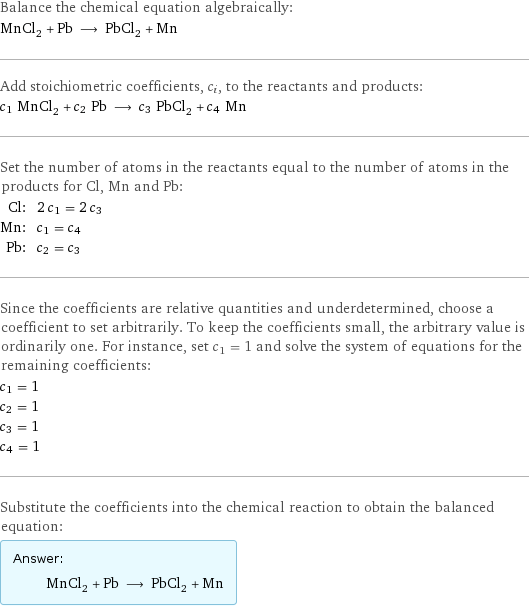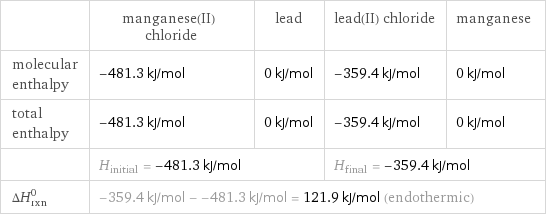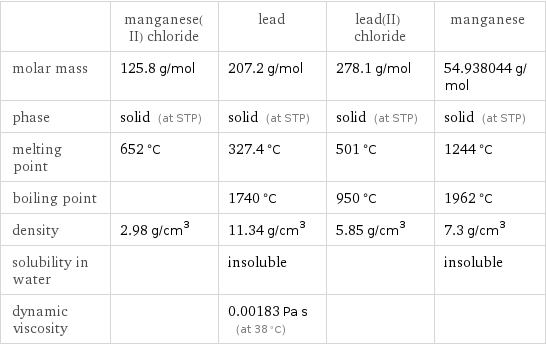Input interpretation

MnCl_2 manganese(II) chloride + Pb lead ⟶ PbCl_2 lead(II) chloride + Mn manganese
Balanced equation

Balance the chemical equation algebraically: MnCl_2 + Pb ⟶ PbCl_2 + Mn Add stoichiometric coefficients, c_i, to the reactants and products: c_1 MnCl_2 + c_2 Pb ⟶ c_3 PbCl_2 + c_4 Mn Set the number of atoms in the reactants equal to the number of atoms in the products for Cl, Mn and Pb: Cl: | 2 c_1 = 2 c_3 Mn: | c_1 = c_4 Pb: | c_2 = c_3 Since the coefficients are relative quantities and underdetermined, choose a coefficient to set arbitrarily. To keep the coefficients small, the arbitrary value is ordinarily one. For instance, set c_1 = 1 and solve the system of equations for the remaining coefficients: c_1 = 1 c_2 = 1 c_3 = 1 c_4 = 1 Substitute the coefficients into the chemical reaction to obtain the balanced equation: Answer: | | MnCl_2 + Pb ⟶ PbCl_2 + Mn
Structures

+ ⟶ +
Names

manganese(II) chloride + lead ⟶ lead(II) chloride + manganese
Reaction thermodynamics
Enthalpy

| manganese(II) chloride | lead | lead(II) chloride | manganese molecular enthalpy | -481.3 kJ/mol | 0 kJ/mol | -359.4 kJ/mol | 0 kJ/mol total enthalpy | -481.3 kJ/mol | 0 kJ/mol | -359.4 kJ/mol | 0 kJ/mol | H_initial = -481.3 kJ/mol | | H_final = -359.4 kJ/mol | ΔH_rxn^0 | -359.4 kJ/mol - -481.3 kJ/mol = 121.9 kJ/mol (endothermic) | | |
Equilibrium constant
![Construct the equilibrium constant, K, expression for: MnCl_2 + Pb ⟶ PbCl_2 + Mn Plan: • Balance the chemical equation. • Determine the stoichiometric numbers. • Assemble the activity expression for each chemical species. • Use the activity expressions to build the equilibrium constant expression. Write the balanced chemical equation: MnCl_2 + Pb ⟶ PbCl_2 + Mn Assign stoichiometric numbers, ν_i, using the stoichiometric coefficients, c_i, from the balanced chemical equation in the following manner: ν_i = -c_i for reactants and ν_i = c_i for products: chemical species | c_i | ν_i MnCl_2 | 1 | -1 Pb | 1 | -1 PbCl_2 | 1 | 1 Mn | 1 | 1 Assemble the activity expressions accounting for the state of matter and ν_i: chemical species | c_i | ν_i | activity expression MnCl_2 | 1 | -1 | ([MnCl2])^(-1) Pb | 1 | -1 | ([Pb])^(-1) PbCl_2 | 1 | 1 | [PbCl2] Mn | 1 | 1 | [Mn] The equilibrium constant symbol in the concentration basis is: K_c Mulitply the activity expressions to arrive at the K_c expression: Answer: | | K_c = ([MnCl2])^(-1) ([Pb])^(-1) [PbCl2] [Mn] = ([PbCl2] [Mn])/([MnCl2] [Pb])](../image_source/e1707a07bbd5f9856527e70332e1811a.png)
Construct the equilibrium constant, K, expression for: MnCl_2 + Pb ⟶ PbCl_2 + Mn Plan: • Balance the chemical equation. • Determine the stoichiometric numbers. • Assemble the activity expression for each chemical species. • Use the activity expressions to build the equilibrium constant expression. Write the balanced chemical equation: MnCl_2 + Pb ⟶ PbCl_2 + Mn Assign stoichiometric numbers, ν_i, using the stoichiometric coefficients, c_i, from the balanced chemical equation in the following manner: ν_i = -c_i for reactants and ν_i = c_i for products: chemical species | c_i | ν_i MnCl_2 | 1 | -1 Pb | 1 | -1 PbCl_2 | 1 | 1 Mn | 1 | 1 Assemble the activity expressions accounting for the state of matter and ν_i: chemical species | c_i | ν_i | activity expression MnCl_2 | 1 | -1 | ([MnCl2])^(-1) Pb | 1 | -1 | ([Pb])^(-1) PbCl_2 | 1 | 1 | [PbCl2] Mn | 1 | 1 | [Mn] The equilibrium constant symbol in the concentration basis is: K_c Mulitply the activity expressions to arrive at the K_c expression: Answer: | | K_c = ([MnCl2])^(-1) ([Pb])^(-1) [PbCl2] [Mn] = ([PbCl2] [Mn])/([MnCl2] [Pb])
Rate of reaction
![Construct the rate of reaction expression for: MnCl_2 + Pb ⟶ PbCl_2 + Mn Plan: • Balance the chemical equation. • Determine the stoichiometric numbers. • Assemble the rate term for each chemical species. • Write the rate of reaction expression. Write the balanced chemical equation: MnCl_2 + Pb ⟶ PbCl_2 + Mn Assign stoichiometric numbers, ν_i, using the stoichiometric coefficients, c_i, from the balanced chemical equation in the following manner: ν_i = -c_i for reactants and ν_i = c_i for products: chemical species | c_i | ν_i MnCl_2 | 1 | -1 Pb | 1 | -1 PbCl_2 | 1 | 1 Mn | 1 | 1 The rate term for each chemical species, B_i, is 1/ν_i(Δ[B_i])/(Δt) where [B_i] is the amount concentration and t is time: chemical species | c_i | ν_i | rate term MnCl_2 | 1 | -1 | -(Δ[MnCl2])/(Δt) Pb | 1 | -1 | -(Δ[Pb])/(Δt) PbCl_2 | 1 | 1 | (Δ[PbCl2])/(Δt) Mn | 1 | 1 | (Δ[Mn])/(Δt) (for infinitesimal rate of change, replace Δ with d) Set the rate terms equal to each other to arrive at the rate expression: Answer: | | rate = -(Δ[MnCl2])/(Δt) = -(Δ[Pb])/(Δt) = (Δ[PbCl2])/(Δt) = (Δ[Mn])/(Δt) (assuming constant volume and no accumulation of intermediates or side products)](../image_source/fce443466be6df1f76d12b444e964f1e.png)
Construct the rate of reaction expression for: MnCl_2 + Pb ⟶ PbCl_2 + Mn Plan: • Balance the chemical equation. • Determine the stoichiometric numbers. • Assemble the rate term for each chemical species. • Write the rate of reaction expression. Write the balanced chemical equation: MnCl_2 + Pb ⟶ PbCl_2 + Mn Assign stoichiometric numbers, ν_i, using the stoichiometric coefficients, c_i, from the balanced chemical equation in the following manner: ν_i = -c_i for reactants and ν_i = c_i for products: chemical species | c_i | ν_i MnCl_2 | 1 | -1 Pb | 1 | -1 PbCl_2 | 1 | 1 Mn | 1 | 1 The rate term for each chemical species, B_i, is 1/ν_i(Δ[B_i])/(Δt) where [B_i] is the amount concentration and t is time: chemical species | c_i | ν_i | rate term MnCl_2 | 1 | -1 | -(Δ[MnCl2])/(Δt) Pb | 1 | -1 | -(Δ[Pb])/(Δt) PbCl_2 | 1 | 1 | (Δ[PbCl2])/(Δt) Mn | 1 | 1 | (Δ[Mn])/(Δt) (for infinitesimal rate of change, replace Δ with d) Set the rate terms equal to each other to arrive at the rate expression: Answer: | | rate = -(Δ[MnCl2])/(Δt) = -(Δ[Pb])/(Δt) = (Δ[PbCl2])/(Δt) = (Δ[Mn])/(Δt) (assuming constant volume and no accumulation of intermediates or side products)
Chemical names and formulas

| manganese(II) chloride | lead | lead(II) chloride | manganese formula | MnCl_2 | Pb | PbCl_2 | Mn Hill formula | Cl_2Mn | Pb | Cl_2Pb | Mn name | manganese(II) chloride | lead | lead(II) chloride | manganese IUPAC name | dichloromanganese | lead | dichlorolead | manganese
Substance properties

| manganese(II) chloride | lead | lead(II) chloride | manganese molar mass | 125.8 g/mol | 207.2 g/mol | 278.1 g/mol | 54.938044 g/mol phase | solid (at STP) | solid (at STP) | solid (at STP) | solid (at STP) melting point | 652 °C | 327.4 °C | 501 °C | 1244 °C boiling point | | 1740 °C | 950 °C | 1962 °C density | 2.98 g/cm^3 | 11.34 g/cm^3 | 5.85 g/cm^3 | 7.3 g/cm^3 solubility in water | | insoluble | | insoluble dynamic viscosity | | 0.00183 Pa s (at 38 °C) | |
Units
